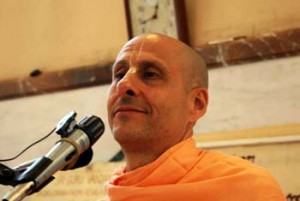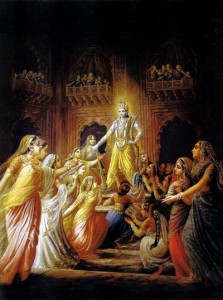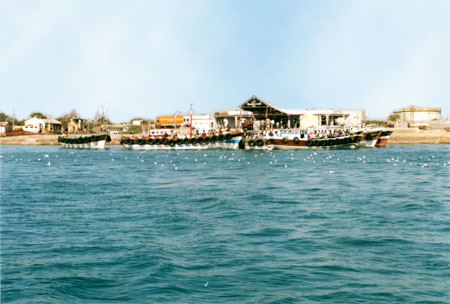Dwarka is the sacred city where Lord Krishna, the Supreme Personality of Godhead, spent most of His time during His appearance on earth five thousand years ago. He performed wonderful pastimes there, including expanding into 16,108 forms and creating 16,108 palaces for His 16,108 queens. In Vrindavan, Lord Krishna lived as a simple cowherd boy, but in Dwarka He lived as a wealthy prince.

Dwarka means “gateway to the Supreme” or “city of gates.”
Srila Prabhupada writes: “The heavenly planets are more celebrated than the earth. But the earth has outshined the heavenly planets because of Dwarka, where Lord Sri Krishna ruled as king. Three places, namely Vrindavan, Mathura, and Dwarka, are more splendorous than the famous planets in the universe. These places are perpetually sanctified because whenever the Lord descends on earth He displays His transcendental activities particularly in these three places. They are perpetually the holy lands of the Lord, and the inhabitants still take advantage of the holy places, even though the Lord is now out of their sight.” (Srimad-Bhagavatam 1.10.27, Purport)
Mood of Dwarka Yatra :
 Not a blade of grass can move without the will of the Supreme Personality of Godhead. One can approach a holy place of pilgrimage only by His mercy. The vibrations of a holy place are sanctified by Tapasya and the transcendental love exchanged between the Lord and his devotees.
Not a blade of grass can move without the will of the Supreme Personality of Godhead. One can approach a holy place of pilgrimage only by His mercy. The vibrations of a holy place are sanctified by Tapasya and the transcendental love exchanged between the Lord and his devotees.
In the days of yore, people who were determined to go on pilgrimage undertook long and arduous journeys. There were no automobiles or trains at the time and pilgrims on their way to Badrinath, Kedarnath or other holy places, would travel for weeks and months. They would walk all the way, begging for food. Sometimes, they would get nothing and they would fast.
Things have changed now. The pilgrimages are convenient and many facilities are available for the comfort of pilgrims. This is a manifestation of Krishna’s mercy towards his devotees who, in this day and age, are caught up in the everyday struggle of life.
But since purification cannot be done without Tapasya, He makes sure to send us a token of hardship
just to polish our consciousness while entering the holy place. So, if there are difficulties in the journey, understand that you have managed to attract Krishna’s attention and be grateful.
Take this yatra as an opportunity to advance spiritually. Don’t talk about anything but Krishna. This will make your heart receptive to the vibrations of the holy place. Constantly chant the holy names or discuss the glories of the Lord. Beyond that, one should speak only as much as is necessary. Take care not to indulge in small talk and gossip.
Do not talk about your life in the material world. Although such talk may appear mundane, it can leave you trapped in illusory miseries. At least during these few days, keep your mind engrossed only in the remembrance of Krishna.
It is very important to help each other on the yatra. In the mood of servant of the servant, we should go out of the way to help each other to derive the full benefit of the pilgrimage. Do not complain while undergoing austerities.
Instead of criticizing, simply accept the experiences as a process of purification through chanting of the holy name of Krishna and glorifying Him. Krishna, while talking about the process of liberation, said he who thanks the Lord when cast into suffering is the one eligible for salvation.
 Krishna married 16,108 women! How did he interact with them? How did they live their routine lives? It is natural for a seeker to wonder. The answers to these questions can strengthen the faith of those visiting Dwarka.
Krishna married 16,108 women! How did he interact with them? How did they live their routine lives? It is natural for a seeker to wonder. The answers to these questions can strengthen the faith of those visiting Dwarka.
When Krishna was here, he was with each and every queen intimately. He was the perfect husband and companion, never letting his wives feel lonely even for a moment. In the morning, Krishna woke up at the crack of dawn as the ‘grihasta’, He would meditate, do pooja, give charity and then leave each of His 16,108 palaces to do His durty as Dwarkadish or the king of Dwarka. He would assist King Ugrasena and go to the Sudharma assembly house. The Srimad Bhagvatam explains how HE would leave in his 16,108 forms. But just before entering the Sudharma assembly house, all the forms would merge into one composite whole. This way he would rule the state of Dwarka. After court, when it was time to meet His queens, He would expand into 16,108 forms and go on to please his wives, who were his pure devotees, by reciprocating the love they showered on Him.
One may ask how it was possible for Krishna to live in 16,108 palaces simultaneously. Because for Krishna, anything is possible. He is the Absolute Truth, he is the embodiment of Adhyatamik Shakti and inconceivable potencies. When Krishna descended on earth, his supremacy was evident, which paved the way for the salvation of mankind through love and devotion. He is all attractive and we are drawn to Him by the inconceivable qualities He exhibits.
The original city of Dwarka, described in the Srimad-Bhagavatam, the Mahäbhärata, and other Vedic scriptures, was a fort city surrounded by sea. Today, a small island, “Bet Dwarka”- is all that remains to remind us of the glorious past. Pilgrims can visit this place too.
The present city of Dwarka is on the shore. It has a population of approximately 30,000, and a tourist population that fluctuates with the seasons. Even though it’s remote—on the west coast and a long way from major cities—many pilgrims make the endeavor to go there.
Dwarka is one of the most important places for devotees because it is one of the four prominent holy places in the cardinal directions of India: Dwarka (west), Puri (east), Rameswaram (south), and Badrinath (north).
The atmosphere in Dwarka is peaceful. The people are pious and don’t seem overly hassled. They happily go to the temple to see the Lord. We arrived in Dwarka at 6:30 in the morning, and although it was still dark, quite a few people were walking towards the main temple, that of Dwarkadhish, “the Lord of Dwarka,” the four-armed Deity of Krishna. By the blessings of Lord Krishna, the opulence of Dwarka survives. Although we don’t see fabulously rich people, the ordinary people live a comfortable life.
Dwarka is a pleasant town on the coast, with a nice strip of beach. The sea is calm there. The climate is moderate, not too hot in the summer or too cold in winter.
